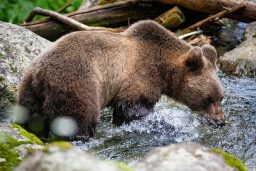Yes, bears do have tails. You may not really have ever noticed it – but all bears do actually have a tail. Not like a dog or cat tail – but it is still there. Short and sweet.
Why Do Bears Have Tails?

Tails evolved in mammals for a variety of reasons – but their main reason in bears now is for protection. They may use them for balance in certain circumstances – but really they are a vestigial tail – a tail this isn’t really doing what it was originally designed to do.
Originally – in the first vertebrate – the tail was a means of propulsion. But after legs took off, that purpose became less so as early mammals filled different niches. Some went up trees, some underground, some went for speed, and others for size – and their tails changed with them. Tails always needed to fulfill a purpose or change – and in bears – it changed to be all but useless. They didn’t need it.
Bears tails – where it joins the body – now only cover the exposed areas of the skin that are not covered with fur. These areas are more sensitive to attack from all sorts of things including parasites and the cold – so need protection. As these areas aren’t covered in the thick fur like the rest of the body – the tail serves this function well – like a short scarf. In many animals still, with longer tails – it performs this same function.
What Do Bears Do With Their Tails?

Bears evolved down the same lines as the carnivore family – cat, dogs, and raccoons – who all have amazing tails. These groups of animals used their tails for actual things like signaling to each other; keeping their balance when running or climbing trees; and, some fluffed them out for helping to keep warm.
As a family, the carnivores needed elaborate tails for speed, precision and agility. Think of cheetahs, otters and racoons.
However, the bears evolved not to need or use them for any of that – they went in a different direction – slow, size, and strength, Therefore, their tails shrank in size over time – and the rest of them got bigger!
How Long Is A Bear’s Tail?
Considering the average pet cat or dog or tail is around 30cm – a raccoon tail is up to 40cm – and a snow leopard is nearly a meter long – a bear’s tail is around 10cm. The Sun Bear has an average tail length of around just half of that – barely even longer than their thick fur.
In order of average length – there isn’t really much in it – but you can group them into 3 groups. Longtails, medium tails, and short tails.
The longest lengths are with the Sloth Bear which is always around 16cm (about as long as a paperback). It is likely that these bears use theirs to help with balance while feeding or climbing – because they do like a tree. Brown Bear tails vary in size but can be over 22cm in some individuals (averaging 14cm) and black Bears can be up to 17cm (averaging 12cm).
Medium tails fall to the Panda (averaging 12cm), Polar Bears (averaging 10cm) and Spectacled Bears (averaging just 9cm). These three bears clearly haven’t really found a real elaborate use for their tails so they have all but vanished.
And with Sun Bear tails as short as just 3cm sometimes, you wonder if it will disappear altogether at some point?
How Does the Length of a Bear’s Tail Affect Its Running Speed?
The bear running speeds table provides valuable insights into how the length of a bear’s tail affects its running speed. By analyzing the data, it becomes evident that bears with longer tails tend to have faster running speeds. This correlation can be attributed to the tail’s crucial role in maintaining balance and stability during high-speed movements. Additionally, a longer tail allows for better maneuverability, enabling bears to navigate challenging terrains with ease.
Do Bears Wag Their Tail?
No they don’t. Bears in the wild do not appear to have a behavioral purpose at all for their tails.
- They don’t need to wag their tail to show happiness – no-one can see it anyway!
- They don’t need it for balance – because their center of gravity is very low and their legs are so strong
- They don’t need it to communicate – as they try to avoid contact and are usually solitary
- They don’t need it for climbing trees – as they have claws and strength (or just stay on the ground)
- They don’t need it for swimming – as they prefer the doggy paddle
- They don’t need it to swat flies – as they have very thick fur and aren’t affected by bites and stings
- They don’t need it to look pretty – they attract their mates with pheromones
- They don’t need it to ward off or distract predators – their big teeth do that instead!









